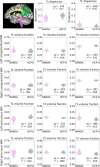Image acquisition and quality assurance in the Boston Adolescent Neuroimaging of Depression and Anxiety study
- PMID: 32339824
- PMCID: PMC7184183
- DOI: 10.1016/j.nicl.2020.102242
Image acquisition and quality assurance in the Boston Adolescent Neuroimaging of Depression and Anxiety study
Abstract
The Connectomes Related to Human Diseases (CRHD) initiative was developed with the Human Connectome Project (HCP) to provide high-resolution, open-access, multi-modal MRI data to better understand the neural correlates of human disease. Here, we present an introduction to a CRHD project, the Boston Adolescent Neuroimaging of Depression and Anxiety (BANDA) study, which is collecting multimodal neuroimaging, clinical, and neuropsychological data from 225 adolescents (ages 14-17), 150 of whom are expected to have a diagnosis of depression and/or anxiety. Our transdiagnostic recruitment approach samples the full spectrum of depressed/anxious symptoms and their comorbidity, consistent with NIMH Research Domain Criteria (RDoC). We focused on an age range that is critical for brain development and for the onset of mental illness. This project sought to harmonize imaging sequences, hardware, and functional tasks with other HCP studies, although some changes were made to canonical HCP methods to accommodate our study population and questions. We present a thorough overview of our imaging sequences, hardware, and scanning protocol. We detail similarities and differences between this study and other HCP studies. We evaluate structural-, diffusion-, and functional-image-quality measures that may be influenced by clinical factors (e.g., disorder, symptomatology). Signal-to-noise and motion estimates from the first 140 adolescents suggest minimal influence of clinical factors on image quality. We anticipate enrollment of an additional 85 participants, most of whom are expected to have a diagnosis of anxiety and/or depression. Clinical and neuropsychological data from the first 140 participants are currently freely available through the National Institute of Mental Health Data Archive (NDA).
Keywords: Anxiety; BANDA; DSM-5; Depression; HCP; RDoC.
Copyright © 2020 The Authors. Published by Elsevier Inc. All rights reserved.
Figures


















References
-
- American Psychiatric Association . American Psychiatric Association; 2013. Diagnostic and Statistical Manual of Mental Disorders. - DOI
-
- Angold A., Costello J., van Kämmen W., Stouthamer-Loeber M. Development of a short questionnaire for use in epidemiological studies of depression in children and adolescents: factor composition and structure across development. International Journal of Methods in Psychiatric Research. 1996;5:251–262.
-
- Barch D.M., Burgess, Harms G.C., Petersen M.P., Schlaggar S.E., Corbetta B.L., Glasser M., Curtiss M.F., Dixit S., Feldt S., Nolan C., Bryant D., Hartley E., Footer T., Bjork O., Poldrack J.M., Smith R., Johansen-Berg S., Snyder H., van Essen A.Z., WU-Minn D.C., Consortium HCP. Function in the human connectome: task-fMRI and individual differences in behavior. NeuroImage. 2013;80:169–189. doi: 10.1016/j.neuroimage.2013.05.033. - DOI - PMC - PubMed
Publication types
MeSH terms
Grants and funding
- R01 MH101521/MH/NIMH NIH HHS/United States
- R01 EB021265/EB/NIBIB NIH HHS/United States
- S10 RR019307/RR/NCRR NIH HHS/United States
- R01 AT007257/AT/NCCIH NIH HHS/United States
- R56 MH121426/MH/NIMH NIH HHS/United States
- U01 MH108168/MH/NIMH NIH HHS/United States
- R37 MH068376/MH/NIMH NIH HHS/United States
- P41 EB019936/EB/NIBIB NIH HHS/United States
- U01 EB026996/EB/NIBIB NIH HHS/United States
- R01 EB020740/EB/NIBIB NIH HHS/United States
- F32 MH114525/MH/NIMH NIH HHS/United States
- S10 RR023401/RR/NCRR NIH HHS/United States
- S10 RR023043/RR/NCRR NIH HHS/United States
- R01 MH099021/MH/NIMH NIH HHS/United States
LinkOut - more resources
Full Text Sources
Medical
Miscellaneous

